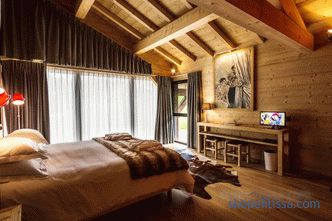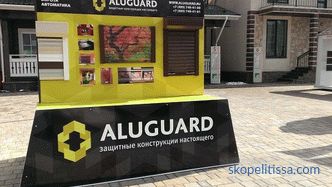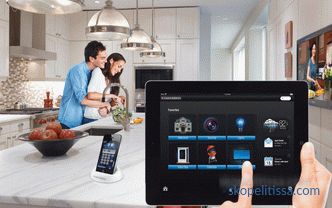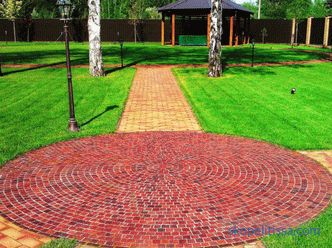If the wooden house at the cottage is built of timber or logs, in some cases it would be useful to additionally sheathe it with decorative materials for the decoration of facades. The article will tell you exactly when the exterior finish of a wooden house will not only positively affect its appearance, but also increase the thermal insulation parameters of the building. You will learn how to properly protect the wood from the negative effects of the environment (precipitation, sun, temperature drops, etc.) and what materials can be selected for this.
What does the exterior lining
Does the lining of the wooden house from the outside, it solves the following practical and aesthetic tasks: increasing the attractiveness of the building’s appearance;
improving the insulating properties of the walls;
increased fire safety due to increased resistance to fire;
improved sound insulation;
protection against rodents (mice, rats etc.);
protection against eating a tree on Ecosystems;
protection against adverse environmental effects (moisture, ultraviolet radiation, temperature changes);
minimizing damage from harmful microorganisms that cause decay ;
minimization of the cost of finishing the facade (eliminating labor-intensive operations on the processing of natural wood).
From which you can choose
Today, dacha owners can choose the right finishing material for their facades, taking into account their financial capabilities, desired technical parameters and design solutions. Most often, the following technological solutions are considered as house trimming options:
-
metal, concrete or vinyl siding;
-
vinyl basement siding;
-
a block house, a planed board simulating a profiled bar or a rounded log;
-
facing brick;
-
lining, houseboard with thorn-groove connection;
-
polyvinyl chloride (PVC) panels;
-
fiber cement boards and siding (composite material from wood fiber, mica, cement, quartz);
-
Thermopanels of foam, mineral wool and extruded polystyrene foam (including clinker thermopanels);
-
porcelain stoneware plates;
-
staining;
-
plastering.
Apparently there is Many options than to sheathe a wooden house outside, a review of materials for the facades will help to learn the features of the use of a particular technology.
On our website you can find contacts of construction companies that offer the service of selecting and installing exterior finish and insulation of turnkey houses. Directly to communicate with representatives, you can visit the exhibition of houses "Low-rise Country".
Vinyl or metal siding
It is a thin steel or aluminum strip with a decorative sheeting. It is attached to the crate, either special metal, or wooden bars treated by impregnation. A lock is provided on the longitudinal sides for articulation of the strips, and a perforation for attachment to the crate. The main advantages of this material include:
-
simple and quick installation;
-
a wide range in terms of colors, textures;
-
non-susceptibility of panels to rotting;
-
ease of maintenance;
-
significant improvement in the thermal insulation parameters of buildings;
-
protection of facades against moisture;
-
panels can be installed at any time of the year;
-
it is not susceptible to the appearance of colonies microorganisms;
-
it is not attractive to insects, they will not damage it;
-
safe for humans (non-toxic);
-
retains its original appearance for a long time;
-
is resistant to temperature changes;
-
does not light up.
Facing brick
It can be used to provide a very beautiful exterior finish of a wooden country house, but brick finishing is a rather laborious process that requires strengthening the foundation of the building.It is also a rather costly version of the skin, but for this the dacha owner receives:
-
excellent frost resistance;
-
increased insulation;
-
long life of the building and its lining;
-
minimum moisture absorption;
-
attractive appearance that is familiar to people;
-
strengthening the bearing capacity of the building.
Block-house
If you want to create an imitation of the fact that the house is built of logs or lumber, then the optimal solution is to use a block-house. Its main advantages are simple installation, long service life, improved sound insulation and thermal insulation of a building.
It should be noted that the naturalness of the material requires antiseptic processing and fire impregnation boards, and the cost of a block house is more than siding.
It might be interesting! In the article on the following link, read about house paneling.
Fiber Cement Decorative Panels
This is a relatively new finishing material. The composite panel has high strength and resistance to temperature and humidity extremes. It has a large enough weight, so it can only be used structures that have sufficient bearing capacity. The protective decorative coating on the plates can be of three types: acrylic, photoceramic, hydrophilceramic. It can be both matte and smooth. Plates are mounted with the help of special guide rails mounted on the wall with clamps.

Plastering
For these purposes, a special facade is used plaster, it has the following advantages
-
good adhesion to various bases;
-
long shelf life without loss of properties;
-
absence of toxic substances in the composition;
-
resistance to atmospheric and mechanical effects;
-
does not absorb pollution;
-
surface dirt is easy to clean wash eat;
-
there are modifications that have the property of self-cleaning;
-
vapor transmission, which has a positive effect on the microclimate inside the house;
-
ample opportunities for design (many colors and textures);
-
simple technology for preparing a compound for plastering.
Lining
If imitation of a bar or a round log is not required, then the building can be sheathed with clapboard. Its operational parameters are exactly the same as the block house, the only difference is the appearance. These are profiled planed wooden boards. On one side there is a groove, and on the opposite side there is a crest. With the help of the strap are interconnected during installation. At production lining dries, passes antiseptic processing.
The main advantages of this material are naturalness, durability, resistance to decay, good heat and sound insulation. The lining of it due to the groove-tongue-and-groove connection is an almost monolithic wooden shield. It is made from such wood species as pine, oak, alder, birch, cedar, abashi, etc.
It might be interesting! In the article at the following link you can read about wall cladding in a wooden house.
PVC panels
The main advantage of polyvinyl chloride panels is their low cost. This material does not require special care, it does not rot and does not corrode. It is not attractive to rodents. Due to fire danger, PVC refers to low combustible materials. Plastic moisture resistant. The widest assortment of panels in size, color, and texture makes it possible to implement virtually any design decisions when they are covering buildings. They are lightweight, so they are easy to install.
The disadvantages of PVC include burning it out in the sun, but This is solved by a special coating in the manufacture of panels. Due to constant temperature fluctuations or severe frosts, cracks are formed on the surface of the panels. Polyvinyl chloride elements are easily deformed due to mechanical effects, and at negative temperatures they may crack.With strong wind due to vibrations of the panels that occur with them, they can be a source of noise.
Thermopanels
Thermopanels solve two problems at the same time - heat insulation and decoration. They are made by applying to the insulation (foam, mineral wool, extruded polystyrene foam) decorative coating that simulates natural stone. This coating is non-combustible and practically does not absorb water.
Clinker panels occupy a separate place among these products. They are obtained by pressing a clinker tile into a polystyrene foam or polyurethane foam base. The clinker panels perfectly imitate brickwork. They have a small weight compared to a brick, and the service life is about half a century. Installation of them also does not require significant effort.
For installation of thermopanels, see the video:
Clearly about the choice of cladding, see the following video:
It can be interesting! In the article on the following link read about the front panels for exterior decoration of the house.
Final conclusion
The modern market offers a variety of technological solutions for cladding country building facades. The choice of the most acceptable one should be made on the basis of financial possibilities, design features of buildings and operating conditions. To do this, it is better to contact the experts.
Rate this article, we tried for you



